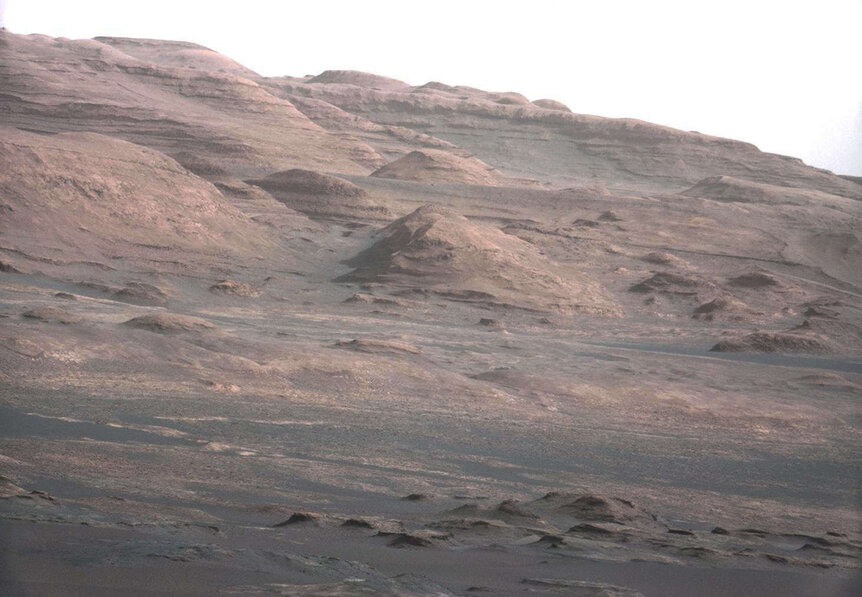Create a free profile to get unlimited access to exclusive videos, sweepstakes, and more!
Was early Mars wet and warm, or dry and cold? Yes.

We know there's water on Mars. And lots of it.
Thing is, it's frozen. With the polar caps, and under the surface even down to mid-latitudes, when you talk Martian water you're talking ice.
While there may be scattered pockets of liquid water under the surface, if you want copious liquid water on the surface then you need to time travel, back to, oh, say, 3 billion years ago (better warp extra fast around the Sun or bring a few extra banana peels). Back then there was quite a bit of surface water, the evidence of which is still around today. River channels, lake beds, even hints of ocean shorelines… all these imply that back then Mars had a thicker atmosphere and plentiful water.
That immediately makes you think it was warm, but hang on. Huge glaciers can have what's called basal melt, where their bases are under pressure and the ice melts, carving channels underneath them as the glaciers flow. So Mars could have been warmer than it is now, but not necessarily been warm. There's some recently found evidence of that, implying Mars was still frozen and cold.
So which is it? A new analysis of sediments explored by the Curiosity rover indicate that it was, well, both, kinda. Certainly warmer than it is now, but still not warm, yet also perhaps not completely frozen either. What the scientists found is that it's more like Iceland. Cold, but not too cold.
They looked at mudstones in Gale Crater, where the rover has been wheeling around since it landed in 2012. Gale is about 150 kilometers wide, and has a huge mountain called Aeolis Mons (nicknamed Mt. Sharp) in its center. Around the flanks of the mountain are sedimentary rock layers, indicating Gale was a lake, with standing water that lasted a long time. It was fed by water flowing from higher elevations around it.
The scientists looked at the mudstone there (literally, mud that has since turned to rock) because it has the finest mineral grains in it, which are ones most affected by chemical changes of weathering. Water flowing through rocks chemically alters it, so by examining the chemistry in a sample the conditions in which the rock formed can be inferred.
Curiosity got a good look at that mudstone, and when scientists examined that data they got some surprises. One is that the youngest material (meaning the grains that were last exposed to weathering) are still very old — three billion years or so. They haven't changed in a long, long time. Weirdly, the youngest sedimentary rocks found in that location are still older than the oldest sedimentary rocks we know of on Earth!
They also found that the minerals showed very little evidence of altering at all, which is unexpected. That means there wasn't much water flowing in that area over geological periods of time.
That in turn implies a colder climate, not a warmer one. They looked at samples from all over the Earth to see which had mineral characteristics similar to what was found in Gale, and determined that the closest analogue on Earth is Iceland. Cold, but still above freezing.
So, in-between frozen solid and a tropical clime, but closer to the former than the latter. They also found that the climate changed over time, and was once much colder, indicating it was more like Antarctica in Gale Crater before warming up a bit to be more Icelandic.
That's pretty interesting. And it doesn't preclude ancient life on Mars, either; liquid water, plenty of minerals, and energy sources like sunlight, lightning, and volcanoes are actually helpful to get life going. So, maybe?
We may find out soon. Perseverance is almost all the way to Mars now, set to land on February 18. It will touch down in Jezero Crater, which has very obvious water flow characteristics, including a big river delta at the northwest part of its rim. This same investigation can be done to see what conditions were like at Jezero in the past.
And this time, the rover is also equipped to look for evidence of primordial life. It will likely take a while for that investigation to get underway and for any evidence, positive or negative, to be analyzed back here on Earth. So stay tuned. We will soon learn even more about what the Red Planet was like back when it was maybe a lot bluer or maybe whiter, whether conditions were habitable, and maybe, maybe, whether or not it was inhabited.
It'll take patience... and perseverance. Hang tight.































